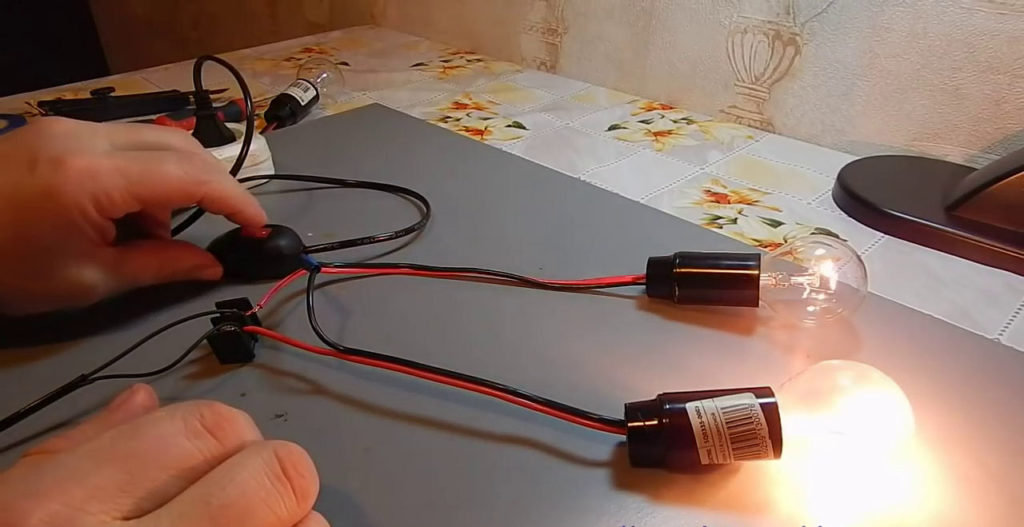How to connect light bulbs in series and parallel
Every day we use light sources. The lamps are connected either in series or parallel. Each method has features and is effective in specific situations.
Can the light bulbs be connected in parallel
This type of connection is the most effective. The bulb is connected to phase and zero. When connecting two or more bulbs, the wires that supply voltage can be twisted.
But more often, all loads are attached to a common cable. Parallel connection is either beam or daisy-chain. In the first, a separate cable is connected to each lamp. In the second, phase and zero are fed to the first light source, the other devices are partially fed.
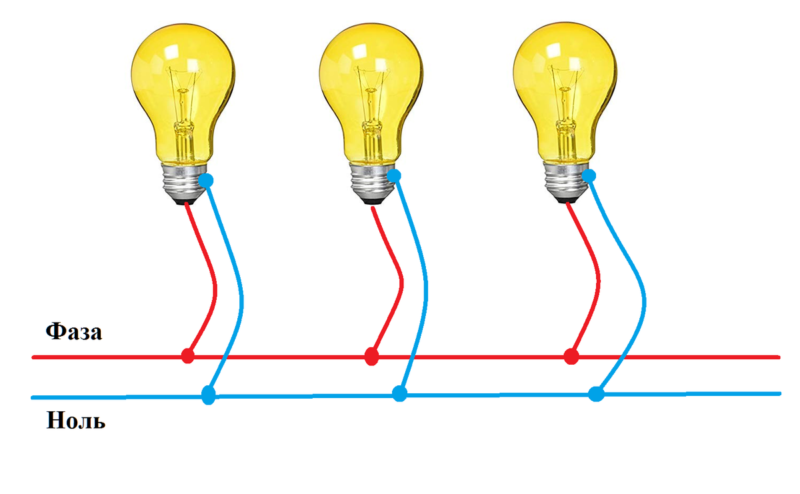
When using halogen lights with a transformer, you must remember that they are connected to the secondary winding of the converter using terminal blocks.
Parallel connection can somewhat smooth out the disadvantages of lighting equipment, to reduce the flicker of fluorescent lamps. A capacitor is added to the circuit to shift the phase of all circuit elements.
Rules for connecting bulbs
Rules must be followed when connecting light bulbs. Consider series and parallel connections.
Serial
The serial connection involves connecting to the 220 V network so that the same current will flow through all the elements in the circuit. The voltage drop distribution is proportional to the internal resistance of the loads. The power is also distributed proportionally.
When using a connection in series with a common switch, the lights will not burn at full power. If you connect lamps of different wattages, the fixture with the higher resistance will have a brighter glow.
A diagram of a standard series connection is shown in the figure below.
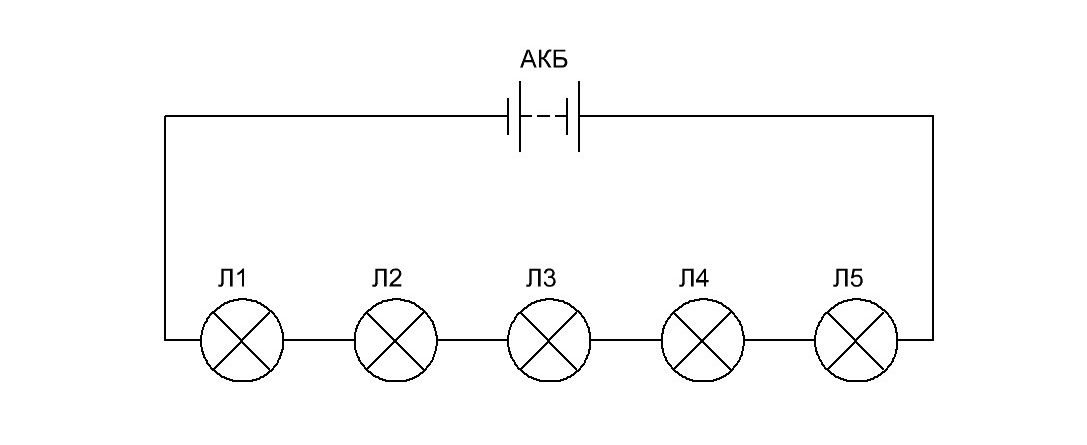
Parallel .
This is different by connecting each bulb with the full line voltage. The current will be different depending on the resistance of the fixture.
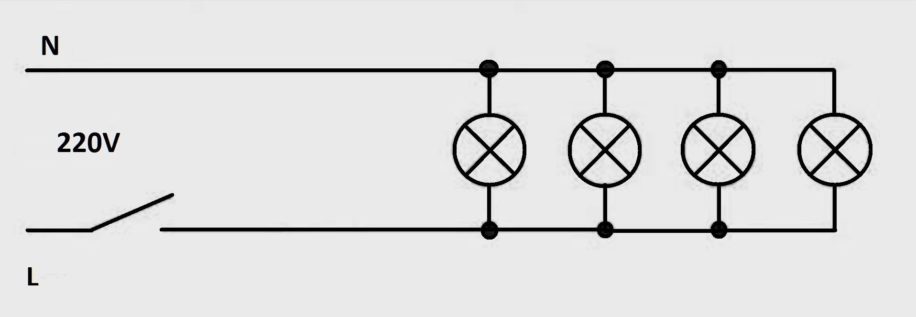
The conductors are fed to the lamp sockets in the same way, sometimes according to the busbar principle, when all loads are connected to a common trunk.
You can connect as many light bulbs as you want to a single line. The switch works the same way as in a series connection.
Pros and cons of parallel connection
Pros:
- If one element fails, the others continue to work;
- the circuit gives the brightest possible light because full voltage is supplied to each fixture;
- Any number of wires can be taken from one lamp to connect additional loads (one zero and a specific number of phases are required);
- Suitable for energy-saving electric devices.
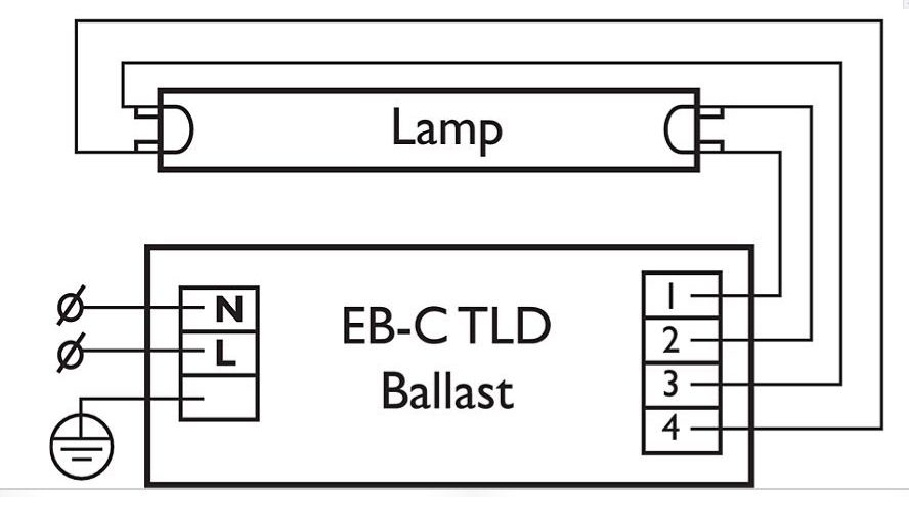
There are practically no disadvantages, except for the large number of conductors in a branched system with many lamps.
Application
In everyday life, parallel connection is very common. For example, Christmas tree lights, where all the bulbs have maximum brightness.
By connecting it, you can create interior lighting of any length. Replacing a burned out element is easy. Two 60 watt fixtures can be swapped for a single 10 watt bulb without affecting the lighting parameters. This circuit property is used by experienced electricians to identify the phase in three-phase networks.
Halogen and incandescent bulbs not only give a bright glow but also heat up the environment. For this reason, they are often used in garages, hangars, or workshops to heat rooms. To do this, they connect the units to the mains by placing them in a metal block. The design heats up to 60 degrees and maintains a comfortable room temperature. However, high power leads to frequent burnout of the lamps.
Video on the topic: WHAT IS LINEAR AND PARALLELED CONNECTION
Parallel connection is used in strip lighting, chandeliers, street lighting. Each lamp can be controlled separately, which increases the convenience of using the common network. You just need to install the right number of switches in the system.
In homes and apartments, not only lights are connected in parallel to the network, but also a variety of equipment.
When creating lighting fixtures with LED elements are often used mixed connection based on a series chain of loads, followed by a parallel connection with the same chain.
Tips to see: How to understand - in series or parallel to connect the lamps or the load
Example of calculating the connection of lamps of different wattages
To understand the differences, it is enough to know Ohm's law and other simple electrical laws.
Suppose there is an incandescent bulb with a voltage of 220 volts. At 50 Hz it is a purely active resistance, so it is more convenient to deal with in the initial questions. If the lamp has a power of 100 watts, then when you plug it in, there will be a current through it I=P/U=100 watt/220 volts=0.5 A (roughly, enough for reasoning). The full 220 volt mains voltage will fall on it. You can calculate the resistance of the filament: R=U/I=220 volts /0.5 amps =400 ohms (approximately).
If you connect a second similar bulb in parallel with the first, it is obvious that all the line voltage will be applied to each bulb. The current consumption Ipcr will split into two streams and through each bulb will go the current I=U/R=220 volts/400 ohms=0.5 ampere. The current consumed will be equal to the sum of the two currents (so says Kirchhoff's first law) and will be 1 A. As a result, both lamps will be under full line voltage, the rated current will flow through them, and the total luminous flux will be equal to twice the flux of one lamp.
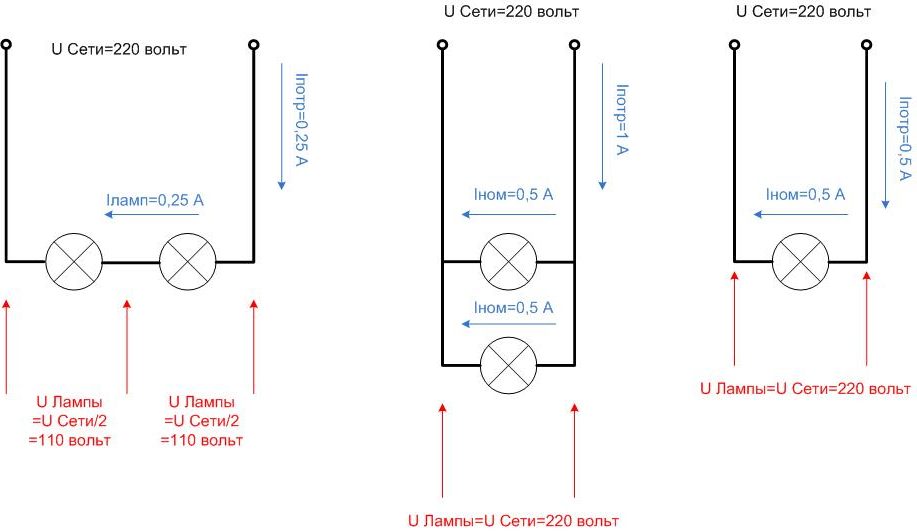
If two identical luminaires are connected in series, the mains voltage will be divided between them, and about 110 volts will fall on each. The total resistance of the circuit would be Rcomm=400+400=800 ohmsand the current through each bulb (in series connection it is the same for each element) will be I Lamps=U/Rob=220 volts/800 Ohm = 0.25 A. As a result it turns out:
- on each bulb only half of the line voltage falls;
- through each bulb current flows, reduced from the nominal current in 2 times.
To estimate the luminous flux of incandescent lamps for this case, we can use the Joule-Lenz law. The luminescence of incandescent lamps is due to the heating of the filament. During time t the filament will release the amount of heat Q=I2*R*t=U*I*t. The current will be halved, the voltage of one bulb also halved. It means that the luminous flux can be expected to decrease by 2*2=4 times. For two lamps, the flux will be halved relative to one lamp in nominal mode. That is, when connected in series two bulbs will shine about two times dimmer than one.
The problem can be solved by using lamps with operating voltage half of the mains voltage. If you apply two hundred-watt light sources at 127 volts, 220 volts will be divided in half, and each lamp will operate in nominal mode, the luminous flux compared to one lamp of the same power is doubled. But this does not get rid of the main disadvantage of this scheme - if one lamp fails, the circuit is broken and the second lamp also stops shining.
All of the above applies to lamps with the same power. If the wattage of the luminaires is noticeably different, the following effects occur in the circuits. Suppose one 220 volt lamp has a power of 70 watts, the other has a power of 140 watts.
Then the nominal current of the first I1=P/U=70/220=0.3 amp. (rounded off), the second one I2=140/220=0.7 Ampere.. Resistance of filament of less powerful luminaire R1=U/I=220/0,3=700 ohm, the second - R2=220/0,7=300 ohm.
Lamp with higher power corresponds to a lower resistance of the filament.
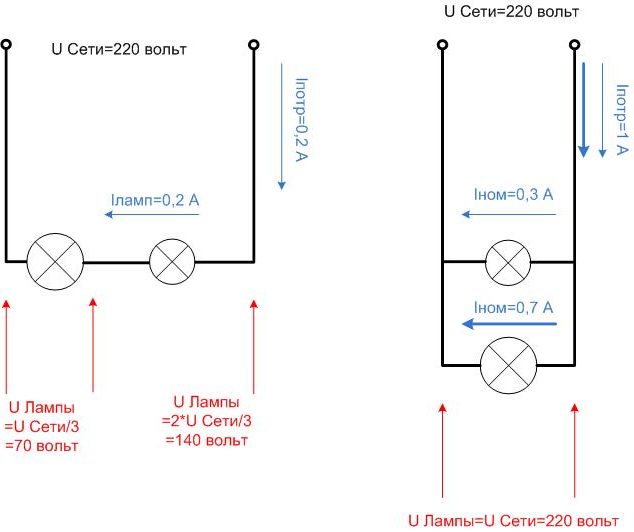
In parallel connection, the voltage of both devices will be equal, and a different current will flow through each lamp. The total current consumption is the sum of the two currents Iptr=0.3+0.7=1 amp. Each bulb works in nominal mode and consumes its own current.
In series connection the current will be limited by the resistance Rcomm=300+700=1000 Ohm and will be equal I=U/R=220/1000=0,2 A. The voltage will be distributed in proportion to the filament resistance (power). On a 140 watt bulb, it will be 1/3 of 220 volts - approximately 70 volts. On a low watt bulb it is 2/3 of 220 volts. That is, about 140 volts. Both lamps will undercalculate because of the reduced voltage and current, but the mode will be light for them. It is different if the lamps are used at half the line voltage. On a lower wattage bulb, the voltage will be higher than allowed, and the difference will be greater the greater the difference in wattage. Such a lamp will soon fail. This is another disadvantage of connecting lamps in series. Therefore, this connection is rarely used in practice. The exception is the series connection of fluorescent lamps. It is believed that with this scheme they work more steadily.

To summarize the differences between parallel connection and series connection:
- in parallel connection, the voltage at all consumers is the same, the current is distributed in proportion to the power of the lamps (if the power is the same, the currents will be equal), the total current consumption is equal to the sum of the currents of all lamps;
- In a series connection, the current through all the lamps will be the same, it is determined by the total resistance of the circuit (and will be less than the current of the lowest-powered lamp), the voltage at the consumers will be distributed in proportion to the power of the lamps (if it is the same, the voltages will be equal).
Using these principles, you can analyze the operation of any circuit.
How to avoid mistakes
It is necessary to connect electrical appliances to the network in accordance with the rules of electrical engineering. Peculiarities of connection are not obvious and can be incomprehensible to people distant from the subject.
It is important to consider:
- Each type of connection has peculiarities related to Ohm's law. In a series connection, the current is equal over all sections of the circuit, while the voltage depends on the resistance. In a parallel connection, the voltage is the same and the total current is the sum of the values of the individual sections.
- Any circuit should not be overloaded as this can lead to unstable operation of appliances and damage to the conductors.
- In a parallel connection, the cross section of the wires must match the applied load, otherwise overheating of the conductors is inevitable with the consequent melting of the winding and short-circuiting.
- Phase is brought into the switch, the zero goes to the light fixture. Neglecting the rule can lead to electrocution when replacing the lamp, because even when the device is off, it is live.
- The main wire from the light fixture is connected to the common terminal. If it is connected to the outlet, only part of the circuit will work.
- Before installing the switch, it is better to mark the wires beforehand. When installing, it will be simple to connect the conductors of the same name to each other.
Failure to follow the recommendations may cause unstable operation of the lighting equipment, rapid burnout of the lamps and cause serious injury with the risk of death.
